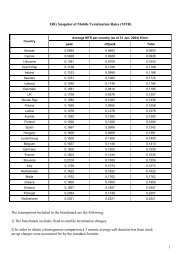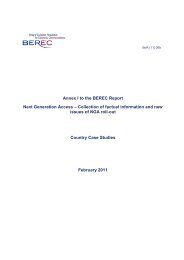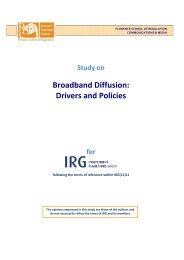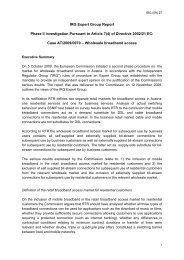Create successful ePaper yourself
Turn your PDF publications into a flip-book with our unique Google optimized e-Paper software.
<strong>IRG</strong>-WG RA (<str<strong>on</strong>g>07</str<strong>on</strong>g>) <strong>WACC</strong> Master Doc<br />
sec<strong>on</strong>d the regulator calculates an efficient borrowing level and associated cost of debt, and<br />
the third c<strong>on</strong>sists in estimating the company specific risk premium and add this to the risk<br />
free rate.<br />
In case a company has not issued debt securities the sec<strong>on</strong>d method cannot be used,<br />
because a credit rating of the company's debt securities will not be available.<br />
Alternatively to the first method, applicable in the case of a company who has not issued any<br />
b<strong>on</strong>ds, notes, nor it is rated by rating agencies, <strong>on</strong>e can estimate the debt premium of<br />
comparable companies’ prevailing yields <strong>on</strong> debt securities (corporate Eurob<strong>on</strong>ds) with<br />
similar risk or maturity.<br />
Again, as in the case of gearing estimati<strong>on</strong>, if the company is part of a wider c<strong>on</strong>glomerate,<br />
the debt premium of the parent company could be used or look at the “true” cost of debt for<br />
the regulated company from available filings to stock exchange of the listed parent company<br />
or from its borrowing facilities and the interest expanses in its financial accounts. It is likely<br />
that the lower end of the interest rates would apply to loans bearing parent company’s<br />
guarantee, while the upper range of the interest rates would represent the interest rates at<br />
which banks would be willing to lend m<strong>on</strong>ey to the company, based <strong>on</strong> its own<br />
creditworthiness.<br />
6.4 Beta evaluati<strong>on</strong><br />
Beta is a measure of the risk of a risky asset relative to the market index. In secti<strong>on</strong> 4.4 four<br />
methods to estimate beta were introduced: historical beta, adjusted historical beta, bottom-up<br />
beta and target beta.<br />
When a company does not have a stock listing, the first two methods cannot be used. On the<br />
c<strong>on</strong>trary, as described in more detail in sub-secti<strong>on</strong> 4.4.3, the bottom-up beta approach is<br />
particularly useful in the case of n<strong>on</strong>-listed companies.<br />
For the selected group of peers, it is necessary to collect informati<strong>on</strong> up<strong>on</strong> total debt, market<br />
capitalisati<strong>on</strong>, effective tax rate (to adjust for tax shield) and equity beta. Further, asset beta<br />
should be derived, to account for differences in leverage am<strong>on</strong>g peer group companies.<br />
Depending <strong>on</strong> the spread of results, the arithmetic or geometric average or even the median<br />
could be used as a proxy for the asset beta of the regulated company.<br />
Alternatively, betas of similar size companies (such as utility companies in the same country)<br />
could be used as a proxy for determining beta for the regulated company.<br />
6.5 Risk free rate<br />
The risk free rate is the expected return <strong>on</strong> an asset, which bears no risk at all, or in other<br />
words, whose returns are certain.<br />
In secti<strong>on</strong> 4.2 it was explained that freely traded government b<strong>on</strong>ds can generally be<br />
regarded as having close to zero default risk and grade zero liquidity risk and thus can be<br />
used for the purpose of determining the risk free rate.<br />
34







